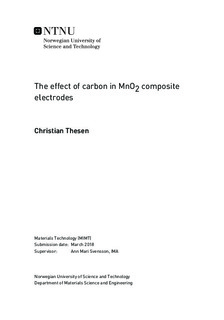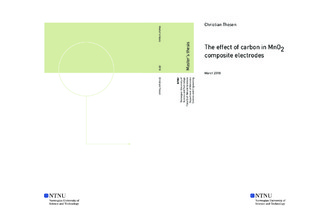| dc.description.abstract | Supercapacitors are promising electrochemical storage devices that might aid in several key technologies such as solar cells, cars, computers and more. In fact, supercapacitors are already used in cars (regenerative braking). They are also used in busses as storage devices that recharge whenever they let on and of passengers. While supercapacitors are considered to be a functioning technology, there are still some challenges that needs to be tackled. Most conventional supercapacitors, such as carbon-based capacitors, have a low energy density. Others, such as the well-known metal oxide RuO2, have both a relatively high energy and power density. Unfortunately, RuO2 is both expensive and toxic. Better alternatives are needed, and MnO2 is a promising substitute. It has a high theoretical capacitance of 1370 F/g, is abundant in the earth s crust, and is harmless. Unfortunately, MnO2 suffers from being a messy oxide, forming more crystal structures than the author can count.
The aim of this thesis is to investigate MnO2 electrodes with and without carbon added during wet synthesis. The method is based on Ghodbane et al s work. The two electrode variations were either made by adding Ketjenblack during synthesis, or Acetylene Black during electrode processing. In both cases, carbon is added as a conductive additive. The electrode substrate used was Toray paper TGP-H-090, 0.28 mm thick. PTFE was used as a binder. Brunauer-Emmett-Teller (BET) and X-ray diffraction (XRD) was used to investigate the surface area and crystal structure of the materials. Thermogravimetric analysis (TG) was used on the Ketjenblack-based MnO2 powder, to measure the carbon content in the powder. The Ketjenblack-based powder had ~25% carbon according to TG. The MnO2 electrodes with Acetylene Black only contained ~14% carbon. All powders were tested with electrochemical cycling in a 3-cell setup, with a Biologic VMP 3 potentiostat.
The measured surface areas of the powders used in this thesis were 46 m2/g, 66 m2/g, 408 m2/g for δ-MnO2-8-F-2, δ-MnO2-8-3, δ-MnO2-8-F-C respectively. All powders had characteristic Birnessite peaks 2θ =12.2-12.5, 24.8-25, 37.0-37.1, 62.9-64.6. Slight variations in d-values could be attributed to the different variations of synthesis parameters. Notable capacitance values were 501 F/g for the Ketjenblack based electrodes, and 474 F/g for the Acetylene Black based electrodes. Both electrodes were cycled with constant current at 0.1 A/g. The obtained values were measured at the 9th and 30th cycle respectively. Indicating a 14.4% /7.7% increase in capacity from the 2th cycle. The increase in capacitance indicates that an activation step has occurred in the electrodes. The Ketjenblack based electrodes had the highest capacitance values
overall, which is an indication that adding Ketjenblack during synthesis will improve supercapacitor electrodes. However, too few parallels have been tested, and more research is needed. | |

